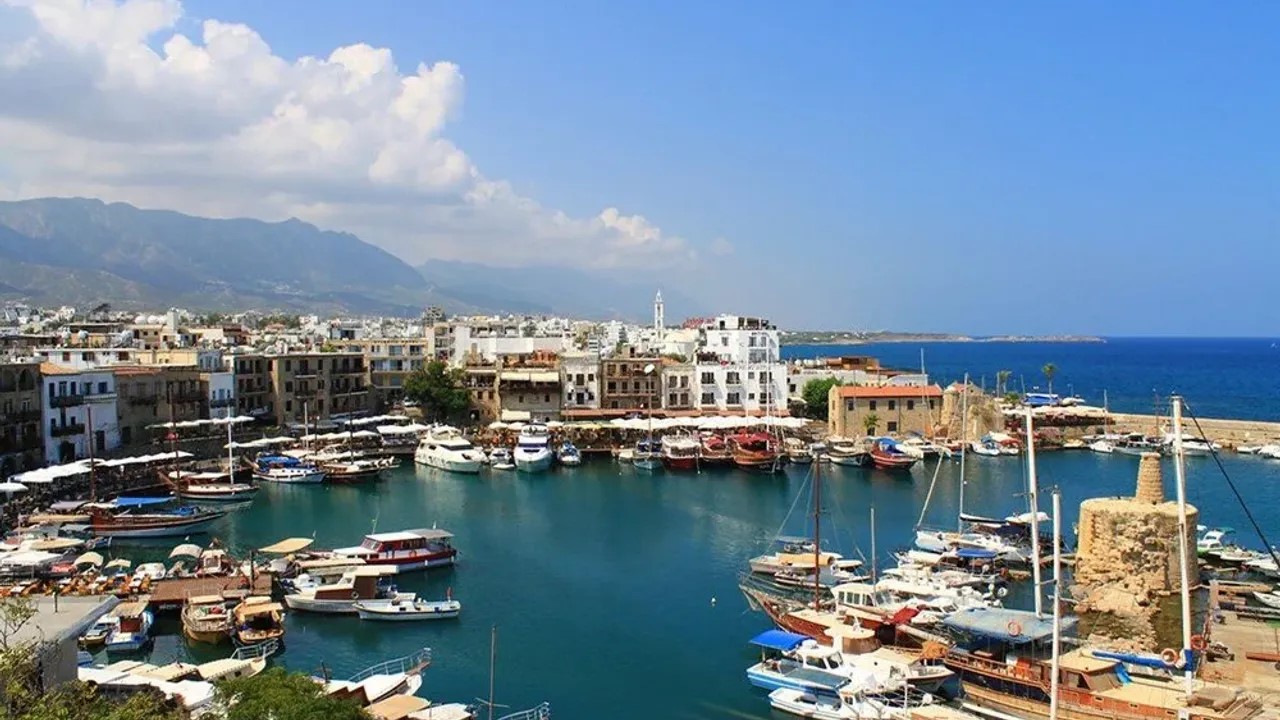Northern Cyprus I look over Girne Harbour lost in thought. The light slowly fades and as the night plays its most colourful game with the day, the candle flames stretch out and fall over the sea. A white sailing boat has already glided into the harbour.
The historic Girne Castle at the tip of the harbour rises out of the dark blue Mediterranean. The stone walls gradually glow red. I realise that Cyprus is not just very beautiful, but has a hidden quality quite different from anywhere else; something which eases tired spirits, brings tranquility and makes even the unforgettable sink into oblivion.
Perhaps it is the fragrance – of flowers in the gardens overlooked by windows with blue shutters in Girne, and of the orange trees along the road in Guzelyurt.
Perhaps it is the fresh scent of a cool breeze from the misty Besparmak Mountains blowing through a castle perched upon rocks, or the salt smell of the turquiose sea on the Karpas Peninsula; the old scent of the photographs in an old woman’s one-roomed cottage in the village of Korucam, or the holy scent from Lala Mustafa Pasa Mosque in Gazimagusa.
Which it is I have no idea. Perhaps Cyprus is a mixture of all these scents. The easiest and most enjoyable way of getting to know Northern Cyprus and experience all its fragrances is to rent a jeep and explore the country from end to end. We began in Girne, whose luxury hotels, casinos and inviting beaches make it the most popular resort in Northern Cyprus. The place where everyone exploring Cyprus gets to meet up is the harbour. Surrounded by café-bars and restaurants, it is always lively.
Right next to the harbour rises one of the most impressive and impregnable mediaeval castles to have survived anywhere. But it is easy to storm Girne Castle today and spend a few hours visiting the several tiny independent museums to which it is home. And what about the other three castles in the Besparmak Mountains? The castles of Buffavento, Saint Hilarion and Kantara kept watch for uninvited ships on the distant horizon and warned the islanders of approaching danger.
To see the scenic beauty which they have been savouring for centuries, all you need is a bit of adventurous spirit and stamina for the climb. From a dizzying wind blown height is a matchless view over the Mediterranean. On a mountainside is the tiny village of Karmi where the whitewashed houses draped with bougainvillea nestle amidst roses, geraniums, almond trees and plum trees. Here most of the inhabitants are German and British. The village of Koruçam near Guzelyurt, meanwhile, is home to a community of Maronites from Lebanon and Syria who settled here centuries ago.
Their houses too are whitewashed, and their windows frame the sea. At the doors stand elderly women dressed in black, matching the black and white photographs on the walls. Melancholy and joy are mingled inextricably here. One of the best ways to get to know the local people is to visit Yorgo’s Place, where the famous Northern Cyprus pit roast is the main speciality, served with hellim cheese, tahini, gabbar (pickled leaves of the milk thistle), garlic sausage and Mediterranean salad.
Then off we go again, leaving the Besparmak Mountains behind and heading for the capital Lefkosa (Nicosia). Here we wander through the narrow streets of the city’s oldest districts of Arabahmet and Selimiye, where the houses in an eclectic mix of styles Ottoman, Lusignan and even in a few cases Venetian in origin, made of adobe or stone, and with bay windows or balconies. Most have been restored. The Church of Saint Sophia (Selimiye Mosque) is one of the capital’s principal monuments, dating from the 14th century and characterised by marvellous stonework.
In Gazimagusa is another but still more imposing monument in similar architectural style, the Cathedral of St Nicholas (Lala Mustafa Pasa Mosque), where light filtering through the long stained glass windows enhances the spiritual atmosphere of the interior.
After visiting the ruins of Salamis, the island’s oldest church of St Barnabas, the Venetian city walls, and Othello’s Tower in Gazimagusa, it is time to head for the Karpas Peninsula. As we drive along through a landscape of yellow wheat fields, I am already excited at the prospect.
The Karpas Peninsula is the furthest extremity of Northern Cyprus, where the island tapers out in a long narrow finger of land towards Turkey. It is a remote unspoilt spot of long sand beaches. When the road ends, we get out of the jeep and begin to walk.
My head is whirling with thoughts of all the scents, faces, and tastes of the island, the salt of the Mediterranean, and flowers I dreamed of gathering. Wait for me, I want to get there first… to the very tip.
Source: Skylife


